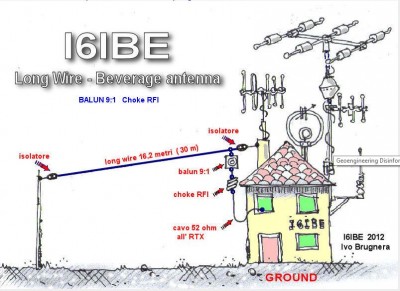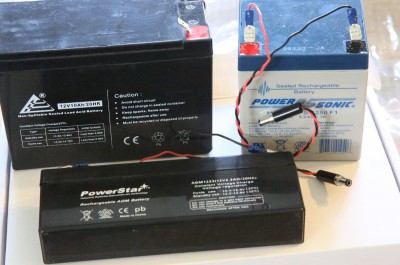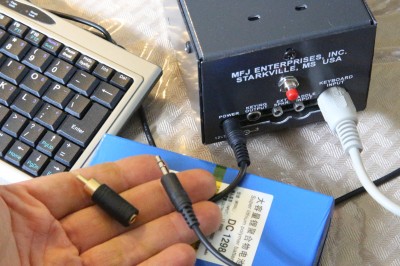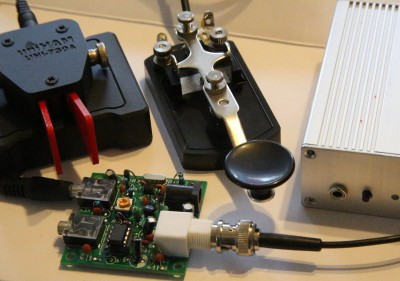
The radio on the right is a completely assembled Rock Mite PIC chip radio. The green board is the Pixie. The red key is the $50 electronic iambic keyer, and the black one is the standard straight key.
Resources:
Pixie QRP Radio – Assembled $12.31
Rock Mite PIC Version – Assembled w/case $37.89
40 Meter Whip Antenna – $23.49 shipped
40 Meter Dipole Antenna – $25.85 shipped
Manual Antenna Tuner DIY Kit $10.99 shipped
Iambic Keyer – Red Paddle $49.99
Iambic Keyer – Te Ne Ke Version
Plastic Straight Key – $19.95 (no cable)
150 Watt Power Amp – $110
About the scariest thing I can think of is to lose contact with my children in a world over the brink of collapse. Most young people don’t even have a land based phone line these days, so if the cell networks go down, that’s it. But there is a way, if you do it now, to establish a communications protocol with loved ones who are hundreds, or even thousands of miles away. As I’ve discussed a few times before in this column, the Amateur radio bands, otherwise known as the Ham bands, under 30 megahertz, are capable of reaching around the entire globe at certain times of the day. Full access Ham radios, covering several bands, or even all the Ham bands, sell for $300 to $10,000, but I found some small radios that cover only one frequency for as little as under $10. You have to still buy an antenna, but the overall cost could be as little as $50. As a bare bones mode of communication on a very tight budget I don’t think you can beat these little radios.
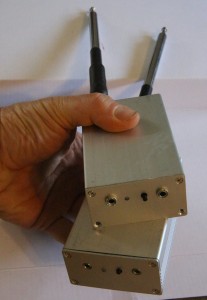
The assembled Rock Mites are the best option if you don’t want to solder and you want a single channel CW (Morse code) that could potentially reach the four corners of the earth.
Since I recently ran a “Worldwide Radio for under $10” article, let me clarify first how this differs. The RTL-SDR radios are USB bugs that only receive. I am in the processing of testing a couple SDRs that do transmit, but they are a totally different technology than the USB bugs and comparatively a lot more expensive for what you get as compared to analog radios with the same amount of coverage. And you do of course have to have the electricity to run at the very least a decent power laptop computer with a good sound card. I had high hopes for SDRs, but so far they have proved to be more complicated and expensive than they are worth.
If you just care about being able to listen to communications from all over the world, an RTL-SDR and a really good antenna are all you really need. These radios in this article both receive and transmit, and from what my research has shown, that is where you get into real money. Radio technology is really old and there are plenty of circuits long past their patent dates, but none of that seems to matter. If you want to transmit, how much money you pay boils down to how many bands do you want to cover and how much power do you want to transmit with. I have found a ton of good $300-$400 Ham radios on Ebay that both receive and transmit on the HF bands, which in Ham language are the 160 meter through 10 meter bands or 1.5mhz – 30 mhz. But cheaper than that you won’t find much.
Low Wattage = High Performance?
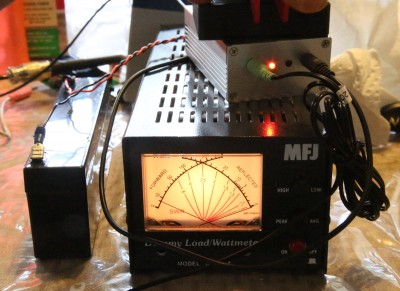
The Rock Mite measured over 5 watts on my dummy load wattmeter. That is enough power on certain nights, with good antennas, in the 7 mhz/40 meter Ham band to reach thousands of miles believe it or not.
There are essentially two parts to any Ham radio. One part is the radio part, which selects the frequency and turns your communications, either voice or electronic pulses (Morse code) into radio waves. The second part is the power amp, which actually sends the radio waves out through your antenna at whatever power you have selected, or that is built into the radio. These radios have very little output in the power section, and they are called “QRP” radios by Hams, because they are under 10 watts. Experienced Hams actually have QRP contests where they limit their wattage to under 10 watts (some say less than 5w) specifically to make long distance contacts with that extra challenge of low power. If the bands are propagating well, and your antenna is set up properly (which I’ll get to), even a radio under one watt can be heard worldwide. That may seem crazy, but people do it every day. I will show you how to up your power on these radios below, but beware that more power means a heavier load, and more power required. These radios alone are a very sound basis on which to rely. You just have to test them first, which means that you either have to get your own Ham license, or ask a couple of Hams to test them for you. After the collapse the license won’t matter, but today it does.
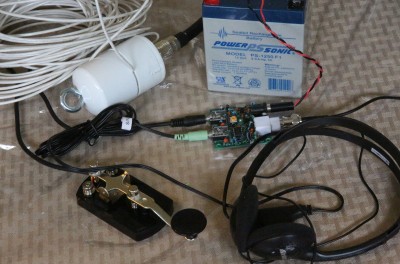
Morse code may seem like an outdated and outmoded technology, but after the collapse, when your only electricity is going to come from wind, solar or hydro power that you own, low power/low amperage radios like this 1 watt Pixie radio are going to be the best game in town. That is a $20 plastic straight key, and the antenna is the 40 meter dipole mentioned in the article. It has two wires 33 feet long, so it needs some space, but it is very sensitive and will handle the power of the booster below.
Is Morse Code Really Outdated?
The answer to that question is surprisingly no. Morse code, or CW, is the most efficient use of a small radio’s power. Encoding and decoding can be done off of your radio time by just writing down the message to send, and writing it down when you receive it.
One of the hardest concepts for me to grasp when I introduced myself to radio technology was the idea of “bandwidth.” A radio signal has a width, and different types of signals have different widths. Modern FM radio signals are huge, like 30,000 hertz wide, because they allow for a huge dynamic range in the music. AM broadcasts are much “thinner,” about 10,000 hertz. But Hams figured out long ago that they could split the AM signal even further, into two “single side bands,” upper side band (USB) and lower side band (LSB), and that this would require half as much power to send a slightly less quality signal just as far. All Ham radios that cover the HF channels will say SSB on them, and they will have a switch for USB, LSB, and CW.
CW is Morse code, and it is very narrow, as narrow as 150 hertz. That makes for a very efficient broadcast at low power, because all of the radio’s power is directed to a very thin signal traveling as far as possible. These radios broadcast and receive only Morse code at 7.023 mhz. They use the most simple circuits possible, and they run on 12 volts, which can be directly from your car battery with your engine off. You will need a specific antenna for the “40 meter” Ham band, but they can be had for fairly cheap. The radios themselves are as little as $5.
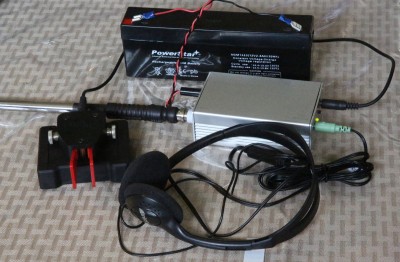
Of all the cheap CW QRP radios on Ebay, the best buy is the Rock Mite in this assembled kit. If you are a hobby solder expert, by all means get the 10 watt radios if you want, but for expedience this is a great radio. This is the red Iambic keyer with it. The Rock Mite recognizes the stereo cable so you can send dits from the left and dahs from the right. There are also programmable auto-codes built into the PIC programming.
Pixie vs. Rock Mite vs. 49er vs. Frog Sounds
If you search Ebay for “qrp transceiver,” you’ll see a ton of different kits come up. Most of them require soldering, and unless you are experienced with a soldering iron I would not suggest you experiment with these. I have built guitar pedals and amps for years and I still find myself making bad solder joints, bridging connections and lifting pads with too much heat. I did buy some of these kits and they are waiting for me to break out my soldering kit, but for now, you are better off to get the finished versions.
My preference is the assembled version of the 4 watt Rock Mite that has a PIC logic circuit built onto it for electronic keying. This allows you to use what is called an iambic paddle keyer. I found that it automatically recognizes the $50 paddle keyers on Ebay, and the left paddle sends a dit/dot and the right paddle sends a dah/dash. This one also is mounted in an aluminum case, which almost none of the other cheap QRP CW radios have, even the assembled versions. For this article I tried the $38 version, and I also bought the $50 version of this radio for an upcoming article on using your computer to send and receive radio messages. It has a com port. Both of these radios will send automatic CQ CQ CQ messages, and can be programmed to even send your call sign, but the translated Chinese directions are really cryptic and will take some experimentation.
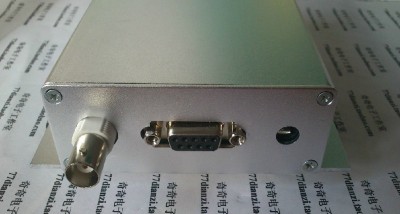
I am not getting into connecting a computer to one of these radios for this article, but there is a step up Super Rock Mite that is only slightly more assembled, and it comes with a COM port connector.
I didn’t focus on the computer connected radios at this point due to both portability and power. My choices here are “bag radios.” With the battery and headphones, they’ll fit in a 1 gallon zip lock bag, and without the battery, hooking it to abandoned car batteries as you travel, the overhead is less than a pound, including a good antenna! You can and should use the links I’m giving you to do your own research into what type of radio suits your needs. I picked two no brainers here to test, but since I don’t have my Ham license yet, I can’t even really demonstrate how to use them. I don’t think the FCC is going to come knocking on your door if you send a Morse code CQ CQ CQ from your little Rock Mite once in a while to see if your daughter 500 miles away can pick you up, but I’m not going to tell you to go break the law. What I can say is be considerate. I hooked up one of my regular radios to listen to see if these radios even worked, and occasionally I would get actual Ham transmissions at this 7.023 frequency. Licensed or not, be courteous, and do your homework as to how Hams operate as per my prior articles.
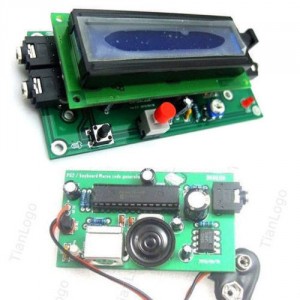
This is the Morse code write and decode set that is on Ebay for under $40. The bottom board connects to a PS2 style keyboard and turns keystrokes into audible Morse code. The decoder takes audio input and turns it into characters on the screen. It can also take input from a keyer, for practice.
The other radio I successfully set up is the assembled version of the Pixie. It sends just over a watt at 12 volts but will run at slightly less power on a regular 9v battery. The kit version of this radio goes for as little as $5 on Ebay, and there is one guy selling assembled kits for $12.31 shipped. I bought two and they arrived in a few days from China, nicely soldered. For some reason there was an extra 1/2 watt resistor in the bag, and I haven’t gotten an answer as to why, but the radio seems to work as is. It didn’t register on my wattmeter, so it is truly low power, but it is the radio part of the radio and it does transmit a strong clean signal.
There is no case on this Pixie radio, and the jacks are right on the board. I had to use a small screwdriver on the trimmer pot to get the radio to not squeal, but once it warmed up and settled in, the frequency stayed rock solid with no real noise. It does not have an electronic keyer so only the dit side of my paddle keyer works, and a regular straight key works fine as well.
There are also radios on Ebay ranging from 1 watt to 10 watts with names like “Frog Sounds,” “Forty-9er,” and a Russian option called “Bitx.” In the last couple weeks a new model has appeared from Greece that looks really robust called Radi0kit, but like the others, these are DIY solder at home kits. All of these circuits are based on time tested designs that were popular among radio amateurs in decades past. It was “a thing” to build a QRP radio into an Altoids mints tin, and as you can see from the photos, I actually bought an old Altoids radio on Ebay to see what it had inside. It was a Pixie board, but unlike these Pixie boards that we can buy today, it didn’t have the jacks built into the board.
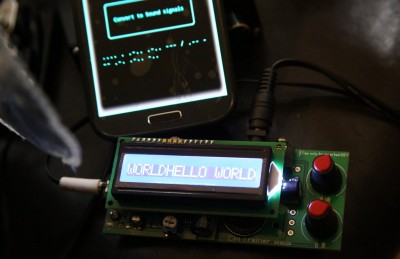
Turning text into audible tons is easiest done on your phone with one of several CW encoding programs. With some adjustment I got the decoder to successfully decode when sent directly from the phone headphone jack, at 20wpm.
I don’t have anyone hundreds of miles away willing to test these radios with me, but I can tell you that I hooked up both of them to my dummy load and wattmeter and the Rockmite showed 3-4 watts. The Pixie is broadcasting, but it didn’t budge the meter, which in fairness isn’t built for testing QRP radios. A dummy load is the best way to test radios without a license, because it doesn’t actually broadcast to an antenna.
Antennas
Far more important than which radio you pick is buying a matching antenna. Ham antennas are a more complicated technology than you could ever imagine. But if you think about it, why wouldn’t it be complex? We are talking about propagating radio waves across the planet using layers of the ionosphere. Then receiving tiny microvolts of signal and converting those into sounds. We lose our cell signals when we move out of line of sight of a cell tower. Ham radio is a miraculous technology that never needed to mature because it is so good.
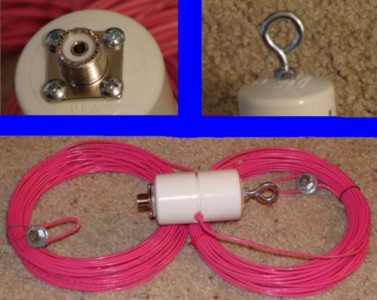
For these radios you will want to buy a 40 meter dipole antenna. If you plan to run a length of connection wire, you should also buy a 1:1 balun to put right before the antenna. This concentrates all of your send power into the antenna instead of wasting it in the connection line.
For these radios you are looking for a “40 meter” antenna, and I found two inexpensive options that both work to varying degrees. For the money, I would get both.
The first is a 40 meter whip antenna at $23.49 shipped. In the add they show the antenna hooked up to the same antenna analyzer that I have and it shows an SWR of 1.2:1, which in Ham language equals pretty darn good. This whip will be much more effective if you hook a long wire to the negative pole on the antenna connection and just lay it on the ground. It is called a counterpoise.
The alternative is an antenna tuner, but I have yet to find a completed kit that is really inexpensive. Most antenna tuners start at about $70 and go up from there, but you can sometimes score small wattage tuners on Ebay for cheap. The DIY kit for a manual antenna tuner up to 15 watts is only about $11 on Ebay, but you have to build it. I ordered a couple but haven’t soldered them because alas, I already have a QRP antenna tuner. I actually got in included with the Altoids radio for $40 total. A manual antenna tuner is pretty easy to use if you experiment with it. You just listen for maximum static on your band.
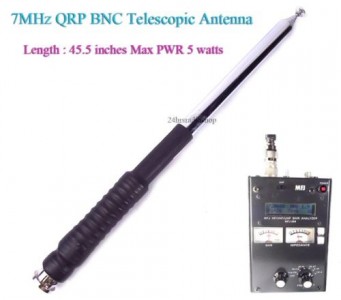
The whip antennas may be all you need if you plan to use these radios as 100 mile walkie talkies. For longer distances you’ll want to add a counterpoise or an antenna tuner.
A more robust antenna specifically for these radios is a 1/2 wave dipole. I ordered one from Ebay for $25.85 shipped. The only think about this guy that I can’t figure out is whether his antenna has what is called a 1:1 balun as part of his middle connector. I tried to take apart the PVC apparatus but he intentionally made it a “black box” that you can’t get apart without cutting. At his price you really can’t even buy the components for cheaper. I assume it doesn’t have the balun. Regardless, it is a good buy.
A balun is an interesting device. If you are going to put your radio right next to your antenna, with a very short connecting line, you don’t really need one. A balun isolates your antenna from your feed line so that your feed line doesn’t itself transmit and suck radio frequency power away from your antenna. If you plan to run a long cable from your radio to your antenna, regardless of what radio and what antenna you use, it is a good idea to include a balun right before the antenna.
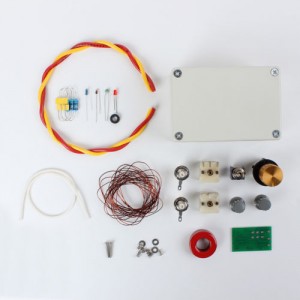
Occasionally I find cheap manual antenna tuners on Ebay, but this kit is all that is out there right now. If you solder, it’s not a huge project for about ten bucks, less than you could buy the components for at Mouser.
Your other option for QRP communications is a “random wire” antenna. It is just a wire, connected to the positive antenna out on the radio. You can Google random wire or longwire on the internet and find the suggested lengths. For 40 meters, in the 7mz range, the best results seem to be about 52 1/2 feet. You should also use an RF choke on the line, as per the diagram I am including here. For a random wire, or end fed dipole, you need a 9:1 balun. They are available on Ebay for as little as 10 bucks, and if you want more wattage, you can find them for $30 or so.
I should also mention connection wire. There are a few types that come with the connectors used for Ham radio. If you can, get LMR-400 or equivalent. It is very stuff with thick wire inside. Compared to RG-8 or RG-58 coax the performance over long runs is much much better. On a low wattage radio you want as little resistance in your cable as possible, and thick heavy cable is important even on powerful rigs. If you aren’t going to be mobile, it is worth the investment. Note also that you are going to need a BNC to PL-259 adapter. I don’t know why they insist on using a half a dozen different connectors for Ham radios, but these two are the most common.
Automating Morse Code
Notice that I didn’t title this “Learning Morse Code.” Because like learning any language, learning and using Morse is all about practice, and regular use. Maybe you have time to “chew the rag” with other hams using Morse code, but I for sure do not. That is why I immediately went looking for ways to both send and receive Morse, or CW (continuous wave) transmissions automatically. So far I have had very little success, because one specific technical detail about these radios.
A real Morse code signal is not generated by a sound. The “keyer” port on any Ham radio is an open voltage circuit, and when you close the circuit, the radio generates a tone. A standard “straight key” is nothing more than two contacts with a spring and a button to make the job of sending Morse code easier. Modern radios, including the Rock Mite, can process signals from a stereo cable and send both dits and dahs, but the basic premise of a “key” is the same.
The electronic Morse code sending circuit boards on Ebay send audio. They do not switch a current on and off. This is also true of all the Morse code smartphone apps. They are great for practicing Morse, or for sending it audibly over an SSB connection, but as a regular keyer they do not work. I bought a keyer/reader combo package on Ebay for $34, and it is mostly useless, for now. I just found a circuit that supposedly converts audio signal to on/off open/close connections and I’m hoping to bread board it for a future article.
The only thing I have found that will actually send the Morse pulses is the MFJ-452, as you’ll see in the pictures. At first it was a bust, didn’t work. But after a call to MFJ support they figured out that the jumper inside was set wrong. When I reset the jumper it worked! As for the Morse generators from China and the phone apps, if you want to join me in my quest for making an automted Morse code sending application, you can check out the Github project for yourself. I found the transformer at packetradio.com, and the rest of the parts I either had or ordered from Mouser.
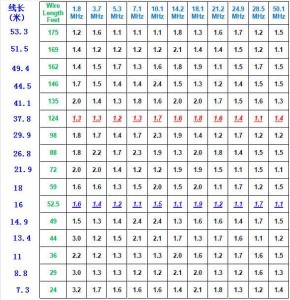
For 40 meters you can see the different SWR ratios for the different lengths. A 1:1 is the goal. A wire of 52.5 feet is good for this balun, but it can’t handle high wattage if you add a linear amplifier.
Morse readers come in a few different flavors. The one that I found works the best is $27 and has two potentiometers on the side, and you adjust the sensitivity with a small screwdriver. If you can get the light really bright it will decode the messages from the phone apps via a direct cord connection, not that this is of any use. Morse is notoriously hard to decode over the airwaves, though it is technically possible. My Android phone app decoder was completely useless, even with no noise floor or interference. It was actually a farce.
Keep in mind that these radios are really inexpensive in the world of Ham transceivers. Real radios with lots of band options and filters are expensive. There are still Yaesu FT-101 tube radios from the 70s going for over $300 on Ebay, and sometimes as much as $700. I have an article coming at some point on HF transceivers, but if you want to see what your options are as compared to the QRP radios, you can search Ebay for (Icom, Yaesu, Kenwood) hf tranceiver. Once you go into one of the radios that are bidding in the $150 – $300 range, you’ll see the “other items” that will lead you to more of the same. There are plenty of old Ham estate radios that work great out there, but be careful to read the descriptions, because many of the cheapies are problem radios that experienced Hams have gotten at swaps and that they just want to get rid of.
For this kind of money, you are getting a lot of radio, and they do actually work. If you want something even a little better and more flexible, you’ll pay a lot more, and you will almost definitely have to solder. I have seen a few YouKits built receivers in the $150 range, but you have to look for them, and they will only have a few bands for CW. If you want a radio capable of SSB, for voice, plan to pay over $250.
Boosting the Watts
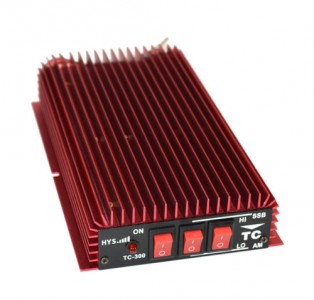
This 150 watt linear amplifier is just over $100s, and runs on the same 13.4 volts that power your radios.
The nice thing about QRP radios I think is that you get what you pay for. All radios receive the same stuff, so as long as you are careful with a good antenna, you have as good a chance at hearing things as any other radio. There are input filters and RF boosters built into full radios for the receive signal, but to a large degree, incremental cost on radios is added by the power to transmit more power at a more tailored signal.
You can, as I said, talk worldwide with only a few watts of power. The bands have to be very favorable, and both parties have to run good antennas, but it is possible. Hundreds of miles is an everyday thing, especially at night on the 7 mhz band. For survival on limited resources, QRP radios only draw in the milliwatts of power, whereas a full featured Ham radio, even a mobile one, will draw 10 amps minimum, which is 120 watts. On a small 5 amp/hour battery, drawing the battery down to half is only going to give you 20 minutes or so with a full sized 100 watt radio. A car battery might give you an hour or two depending on the age of the battery.
If you want to boost your HF Ham signal, you can use a straight linear power amplifier. I found a couple of them that are reasonable, and this one is generally just over $100 shipped. It claims to send 150 watts, but I have yet to hook it up to my wattmeter from the QRP radios. I also bought some circuit board linear amplifier kits, but I haven’t found any that are worth considering for a non-hobby/survival budget. The ones from Russia are cryptic at best, and they require a huge heat sink. This red one seems like a safe bet.
Powering Your Rig
My intention with this project was to create a bag radio that you can give to loved ones, so that when the time comes, they can follow a simple set of directions to at least have a chance of making contact after the normal modes of communication go down. To do that you need to have a power source for your rig that fits in a bag, and that won’t need to be recharged for hours of occasional use. My suggestion is to use 12 volt (actually 13.4-8v) sealed lead acid batteries that are meant for golf carts and kids scooters. They come in a number of sizes, from about 2 amp/hours to 10 amp/hours, with proportional size and weight. The grey ones you see here are $26 for 2, and they are 5 amp/hours each. The long black ones are 2.3 amp/hours and $12.50 each. The large 10AH batteries are $25.25 for 2.
All of these batteries come with ears for clip connectors, and they are the same connectors you can get at Walmart in a kit with a crimper for about $5. I just take a regular 5.5×2.1 jack connector and crimp the clips right onto the wires. It would probably be smart to put an inline fuse, but I never have and though I do see sparks occasionally when I plug them in, I haven’t fried anything yet. The receive current on these radios is only about 10ma and even transmit is in the 100s of milliamp range, so a one amp fuse would be overkill.
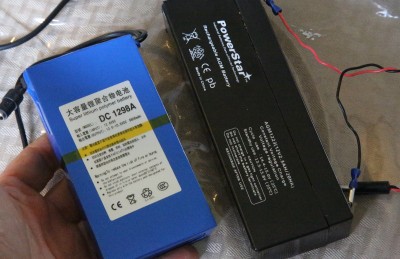
These polymer li-ion batteries look great, but they are only about 1ah and in my experience fail too easily.
What I don’t suggest, and I wish I didn’t spend my money on, are polymer lithium ion battery packs. They look great, because they have on/off switches, and they come with a wall wart charger and both male and female charging connectors wired right in. I knew that these batteries tend to get hot on discharge and even while charging, so they are a fire hazard, but I didn’t realize that they also fail really easy. One of the two I tested failed on me with a simple thing of connecting a device while charging. If their are warnings about this they are in Chinese, so I had no idea. The polymer batteries are really expensive, like $30 for about 1 am/hour, so even though they will power one of these radios for a long time, I wouldn’t consider them.
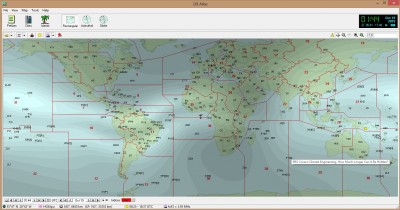
This is a screen shot of DX Atlas. The overlay is the F2 layer of the ionosphere, and it shows where you might be able to reach if you are in a certain spot. From South Florida, on this map, I could possibly reach into Morocco and the Western provinces of Canada right now. Download DX Atlas and you’ll get maps like these for free.
Finding the Bands
I hate to say this, but when it comes to worldwide communications on the HF bands, the radio is the easy part. Learning about antennas, filtering and band propagation is hard, and even if you never get your license, you do have to learn some of it if you ever want to be successful. I personally have not had the time to properly learn all of the very basics, even though I have been able to put up a real 80 foot multi-band dipole and get some contacts logged. Electronics in general is a field of study that never ends, and radio waves and radios are just a subset of that. I’ve been building guitar amps for 20 years and a lot of the electronics involved in radios were not new to me, but I have learned a ton in a very short time, enough to figure out how much I don’t know lol.
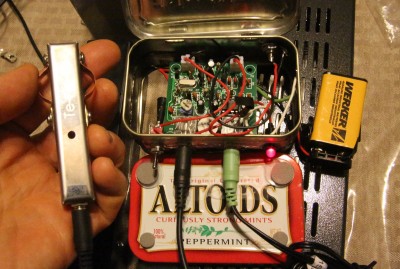
The classic QRP radio in the Ham world is built into an Altoids tin. Out of curiosity I bought this one on Ebay because it came with a mini antenna tuner, and inside I found the “other” Pixie board on Ebay, the one that doesn’t have the 5.5mm jack installed in it. This guy taped together two Altoids tins so he’d have room for the battery, and for some reason put an RCA plug for the antenna. But it works! The keyer in my hand is the Te-Ne-Ke portable iambic keyer linked above. This Pixie doesn’t support the stereo cord dit/dah either.
The HF bands ride on the F2 layer of the ionosphere, and I found a nifty program that helps you visualize the areas that you can connect to at any given minute of the day, by plotting the patterns that the layers favor around the globe. Download DX Atlas and you’ll get maps like the one you see on the right here. You’ll also see the license prefix for all the regions of the globe, so if someone is calling CQ from a VK prefix, you’ll know that it’s Australia. Cool stuff, and it should get you on your way to a lot of other free programs and a lot of free knowledge as of today is still out there. Once the music stops this will all be gone, so be a wise person and take advantage of it today. Ten years early is better than one day late.
